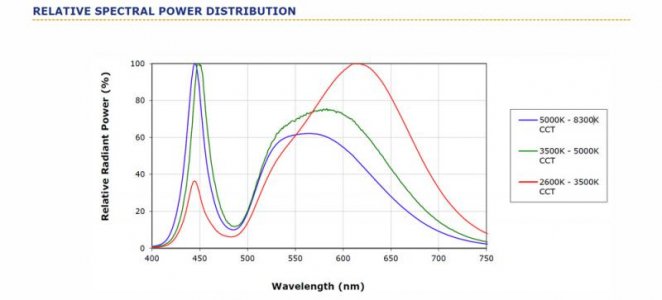Lassef
Member
Thanks for the compliment Lasse. Yes, parallel connection. The 3 sets of leads from the dimmers feed the center terminal board. A jumper set for each color goes from the center terminal to the two outer terminals. This allows me to keep the 22AWG wires from the LEDs a little shorter. The terminals are large enough to take up to 4 of the 22AWG wires.
I haven't done any current measurement with the set up completed and on the dimmers, but it's something I should probably do. I took some current readings early on in the build when I was using 2 to 3 ohm resistors to knock down the power supply voltage. There was a slight variance between some of the LEDs at the same forward voltage, but the ones I tested were fairly close. Basically I'm not that concerned about the current since I have the power supply adjusted down to 10 volts & the dimmers downstream of that to further reduce the voltage as desired. As you know, maximum forward voltage varies somewhat between the different color LEDs, but they should all be able to handle 10 volts no problem & with the way I have it set up, it's unlikely that their maximum voltage will be exceeded.
Maybe I'm wrong, but in terms of power led, I am more concerned about over-current than for the overvoltage. It is the current that can burn them out. An example. You have a source that provides a constant voltage of 10 V and a current of 10 A. 10 LEDs that can handle 1 A. With a parallel connection, each chip would get its FV of 10 V and its maximum current of 1A. One fails and then the 10 A divided in 9 instead of 10 and each of the remaining chips will receive 1.1 A, and so on.
The multi-chip of 10 watt consists of 9 individual LEDs connected in 3 parallel loops with 3 LED in serie. This mean that if one LED is broken, it will not affect much, but if the whole chip break, the remaining will be affected with a current increases. Theoretically your setup will give a current about 770 mA (calculated from 250/12) to each chip and each chip manage 1 A. So the danger is not that great. It would require that it broke down 7 whole cip for you to have a current over 1 A. But as you pointed out, they have different FV and this can also affect how the current is distributed between the different chips.
So this is how I understand the problems associated with power LED. They are designed for a constant current, and not for a constant voltage
But your design is "up and running" so your design also seems to work.
Sincerely Lasse

